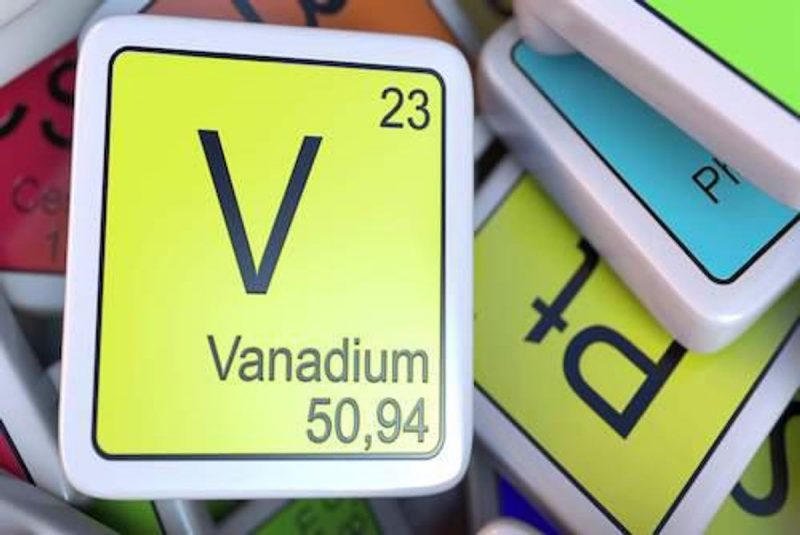Named after Vanadis, the Norse god of beauty, vanadium is a silvery-gray transition metal that was discovered in 1801.
Vanadium occurs in about 65 different minerals, and is mined as a by-product of other metals, usually uranium. It is also found in deposits of phosphate rock, titaniferous magnetite, uraniferous sandstone and siltstone. Aside from that, it is present in bauxite and in carboniferous materials such as crude oil, coal, oil shale and tar sands.
Many investors believe the vanadium industry is compelling and are interested in getting involved in this evolving market. Read on for a brief overview of the metal, from supply and demand to how to invest in this exciting industrial and battery metal.
What factors impact vanadium supply and demand?
Vanadium applications have grown in recent years, contributing to price growth. The vast majority of vanadium is used as an additive in the steel industry to make a high-strength product that is lighter, stronger and more resistant to shock and corrosion.
Vanadium content of less than 0.1 percent is needed to double the strength of steel, and although other metals — including manganese, molybdenum, niobium, titanium and tungsten — can be interchanged with vanadium for alloying with steel, there is no substitute for vanadium in aerospace titanium alloys.
Over the last few years, China has increased its vanadium use, producing steel rebar with high tensile strength for construction. Vanadium compounds are also used in nuclear reactors because they have low neutron-absorbing properties. Vanadium oxide is used as a pigment for ceramics and glass, and can act as a catalyst in the production of superconducting magnets.
In addition to the steel alloy sector, the metal is often used to make parts for jet engines, as well as crankshafts, axles and gears. What’s more, vanadium redox batteries are currently generating excitement because they are reusable over semi-infinite cycles, and do not degrade for at least 20 years, allowing energy storage systems the ability to bank renewable energy.
However, these batteries are quite large compared to lithium-ion batteries, and are better suited for industrial or commercial use rather than for use in electric vehicles. That said, there are a number of companies around the world working on developing the technology for residential and smaller-scale use.
Project Blue co-founder Jack Bedder is looking to further commercialization of vanadium redox batteries, forecasting growth of more than 35 percent per year to 2027, driven by demand from China.
“I think we will continue to see more announcements regarding planned installations, but the question is how big will these batteries be, and thus how much vanadium will they need?” he said. “I also expect more commitment to build electrolyte capacity.”
On the supply side, China was the world’s largest producer of vanadium in 2022 by far, contributing 70,000 metric tons (MT). Russia came in at a distant second with output of 17,000 MT, and South Africa was in third place with 9,100 MT. China also has the highest vanadium reserves globally, and ranks as the top consumer of the commodity.
Russian-owned Evraz is a large vanadium producer with assets in Russia and Czechia, and is a major supplier of ferrovanadium to the European steel market. In the first half of 2022, Russia’s invasion of Ukraine and subsequent trade sanctions had some market watchers concerned over the impact on vanadium supply.
However, according to CRU Group analysts, ‘very little impact has been seen. This has been confirmed by the market, with prices dropping since March and resting back at pre-conflict prices for the past four months.”
How to invest in vanadium?
Vanadium bullion is available from private individuals, but the metal is not publicly traded, and so most experts do not advise investing in physical vanadium. Instead, vanadium stocks are a common way to gain exposure.
Largo Resources (TSX:LGO,NASDAQ:LGO) owns and operates the Maracas Menchen mine in Brazil, and has annual vanadium output of between 11,000 and 12,000 MT. The company supplies vanadium products for multiple applications, and has developed vanadium redox battery systems for advanced renewable energy storage solutions.
Aside from Largo, few other publicly traded companies are currently mining vanadium. However, many companies are exploring for the metal or developing vanadium projects. Below are some examples listed on the TSX, TSXV and ASX.
Securities Disclosure: I, Melissa Pistilli, hold no direct investment interest in any company mentioned in this article.

